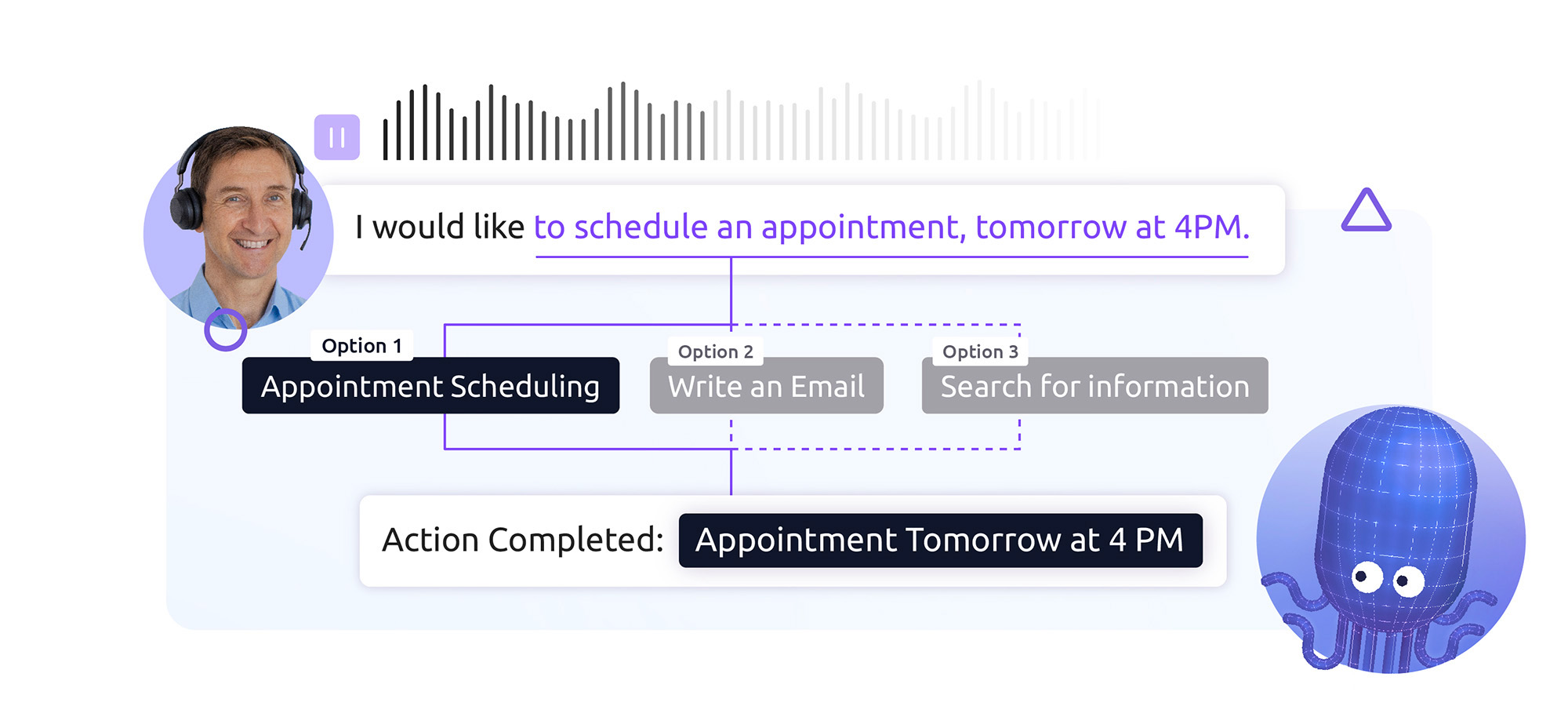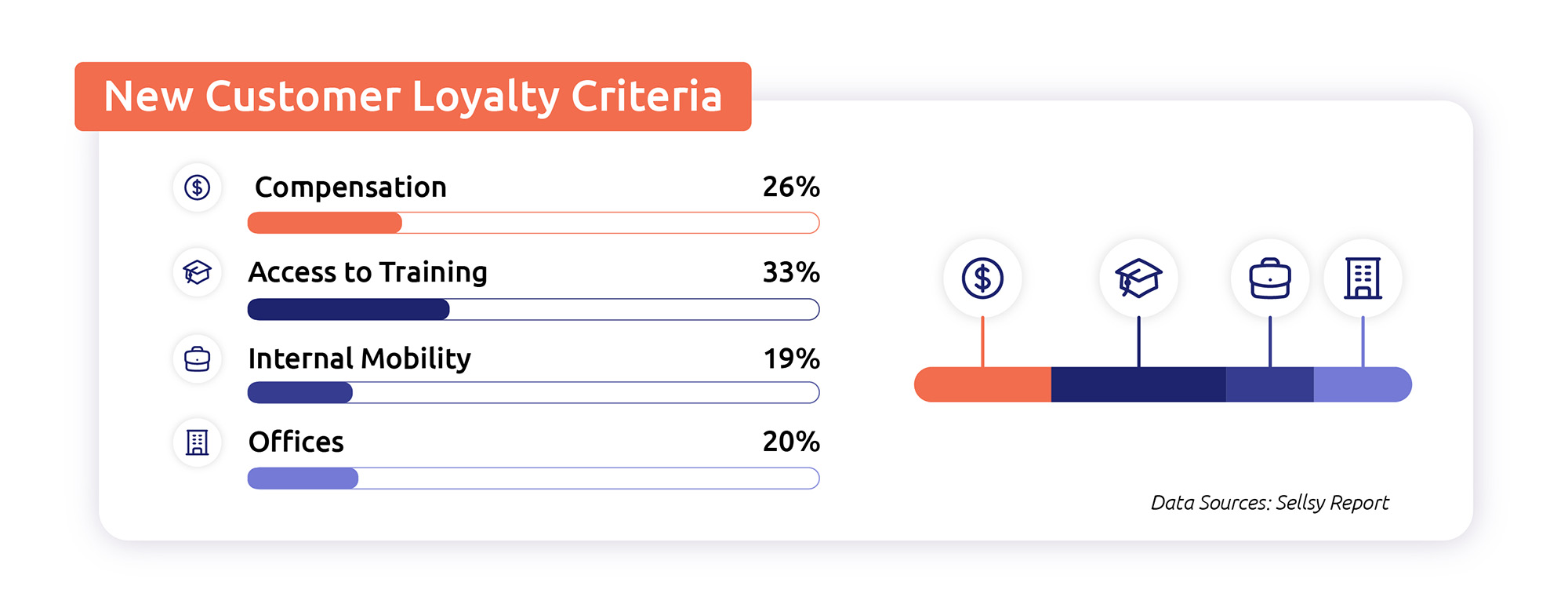Artificial intelligence, the new pillar of sales prospecting
The facts are clear: today’s salespeople spend only a third of their time on activities directly linked to sales. The rest is eaten up by time-consuming tasks with little added value: administration, reporting, meetings, travel…
This is where AI enters the sales prospecting arena, with the promise of automating a large number of workflows and tasks and enabling salespeople to refocus on their core business.
Thanks to machine learning and natural language processing, AI tools can take care of writing emails, scheduling appointments, finding information about prospects…

More and more CRM and customer interaction management platforms are integrating AI functionalities to boost sales productivity and efficiency.
Our Diabolocom platform, for example, offers several AI-based modules to optimize agents’ day-to-day work and reinvest them in customer relations.
But AI’s contribution goes far beyond this. By analyzing masses of customer and market data in real time, AI enables the hyper-personalization of sales relationships. Generic arguments and standard proposals give way to tailor-made interactions, better adapted to the profile, needs and specific context of each prospect.
AI even promises to revolutionize the way we decipher customer needs. By analyzing emotions and verbal signals, it can help sales reps to better understand their interlocutor’s state of mind and adapt their approach accordingly.
In this field, Diabolocom offers its users an AI-based sentiment analysis module that detects irritants and predicts prospects’ needs based on an analysis of telephone or written conversations.
Of course, AI is still in its infancy in the world of sales, and not all companies are in the same boat. It’s mainly SMEs with 20 to 49 employees that are experimenting with these technologies (3 times more than large groups). But one thing is certain: companies that master AI now will gain a decisive competitive edge in the long term.
Tomorrow’s salesperson: from salesman to consultant
Gone are the days when simply extolling the virtues of your product was enough to close a sale. According to the Sellsy study, customers now expect much more than just a sales pitch. They want a real partner, capable of understanding their specific issues and providing personalized advice.
It’s a real paradigm shift in the world of sales prospecting and sales in general. Salespeople must take on a new role: that of consultant. More than just a salesman, he’s becoming a business expert, bringing real added value to his customers. Their objective is no longer simply to sell their product, but to help their contacts solve their problems and achieve their objectives.
This requires salespeople to develop in-depth knowledge of their sector and of their customers’ uses. They must be able to share concrete cases, examples of ROI, user testimonials…all tangible elements that prove the relevance of their offer and reassure prospects of its potential.
But this expertise is not enough. The sales consultant must also excel in human relations. Empathy, active listening, emotional intelligence… These soft skills are more important than ever in establishing a bond of trust with your contacts. Because beyond the one-off sale, the challenge is to build lasting, mutually beneficial partnerships. To find out more, read our article “How to integrate emotion into customer relations“.
Tomorrow’s salesperson is no longer a simple executor, but a true strategic partner. An expert who puts his or her knowledge and interpersonal skills at the service of his or her customers’ success.
Artificial intelligence can provide valuable support for this change in the salesperson’s posture and role. In this respect, Diabolocom integrates an AI function that feeds on the company’s knowledge base to help sales reps and sales administrators find answers to their prospects’ queries more quickly, thereby helping to reduce average handling time (AMT).
Cross-selling and up-selling: growth levers not to be neglected
It’s not just sales prospecting that’s being transformed, but sales activity in general.
A salesperson’s work doesn’t stop when the contract is signed. On the contrary, it’s often after the first sale that the greatest opportunities for growth arise.
On average, existing customers account for 72% of a company’s sales, compared with just 28% for new customers. A finding that underlines the strategic importance of continuing to cultivate customer relationships over the long term.
To achieve this, there are essentially 2 sales techniques:
- Cross-selling involves offering customers products or services that complement those they have already purchased. The aim is twofold: to increase the average basket, but also to enhance customer satisfaction by offering a more complete and personalized solution.
- Up-selling, which aims to encourage the customer to opt for a higher-end or more complete version of the product, by highlighting additional benefits. This is what airlines do, for example, by offering paying options such as priority boarding or seat selection.
But to succeed in cross-selling and up-selling, you need to know your customers inside out. This means analyzing their purchasing history, habits and preferences in detail, and personalizing each recommendation according to these insights.
That’s why training sales teams is key, as they need to be able to spot opportunities for additional sales.
Cross-selling and up-selling are therefore powerful levers for boosting sales and building customer loyalty. These practices are all the more strategic in a context where the cost of acquiring new customers continues to rise.
The great return of the face-to-face in the post-Covid world
Three years after a pandemic that accelerated the development of telecommuting, it’s clear that face-to-face contact is making a comeback in the world of sales prospecting.
Trade fairs, customer meetings, product demonstrations: face-to-face interaction is back in vogue, and with it all its potential for boosting sales and customer relations.
It has to be said that face-to-face contact offers a level of engagement and connection that the virtual can barely match. In the presence of their interlocutor, salespeople can rely on a whole arsenal of non-verbal signals – body language, facial expressions, tone of voice – to decipher their reactions and adjust their discourse in real time.
Face-to-face contact is another way of capturing the prospect’s full attention. Immersing the customer in the brand’s universe, whether at a stand or in a showroom, creates an immersive, memorable experience.
But face-to-face contact isn’t just a matter of feeling. It’s also a business gas pedal. It enables us to forge stronger, longer-lasting commercial relationships, ones that are more resilient to the vagaries of time and the demands of competition.
Against this backdrop of the renaissance of face-to-face contact, it’s important for companies to ensure that their field sales staff have the right tools to stay in touch and connected while on the move.
Gone are the days of the solitary, autonomous salesperson. In 2024, sales teams are becoming increasingly structured and specialized in order to improve efficiency.
This underlying trend responds to a dual imperative: adapting to new customer buying patterns and optimizing resources in a context of accelerated digital transformation.
This specialization of roles in sales prospecting is based on the different stages of the prospect’s life cycle. Profiles such as the Sales Development Representative (SDR), focused on qualifying leads from inbound marketing, or the Business Development Representative (BDR), an expert in outbound prospecting.

Their mission: to feed the sales pipeline with qualified opportunities, which are then passed on to Account Executives for conversion into sales.
But specialization doesn’t stop when the contract is signed. More and more companies rely on Customer Success Managers (CSMs) to support their customers over the long term, maximize customer satisfaction and identify cross-selling and upselling opportunities.
This hypersegmentation of sales roles helps to rationalize efforts and allocate resources where they have the greatest impact. Each profile can concentrate on its core expertise, whether that’s sales prospecting, negotiation or loyalty building.
Nearly half of small businesses (with fewer than 5 employees) continue to rely on a single, multi-skilled salesperson to manage the entire sales cycle. This multi-skilling can make sense in a context of limited resources and close proximity to customers.
Specialization or versatility, the key is to adapt your sales prospecting and CRM organization to your size, market and objectives.
Recruiting and retaining talent: the new HR challenges facing sales teams
Attracting and retaining the best sales talent has become a strategic challenge for companies. Human resources departments need to rethink their approach to recruitment and retention.
The stakes are high, insofar as the performance of sales teams directly conditions the company’s growth.
The first trend to emerge in this field is that diversity is becoming a key criterion in sales recruitment. Beyond the ethical imperative, companies are becoming aware of the concrete benefits of a diverse sales team: richer perspectives, enhanced creativity, better understanding of customer expectations…
But it’s not enough to recruit the best people – you have to be able to keep them!
Companies use a number of levers to retain their sales staff. At the top of the list are material benefits such as a business telephone or company car, closely followed by the working environment (location, office size, team).
But beyond these classic incentives, new criteria are emerging. For example, 33% of companies rely on broad access to training to retain their talent, while 19% value internal mobility.

Remuneration remains an important factor, but only comes third (26%). Proof that today’s sales people are looking for meaning and prospects for advancement, beyond the simple financial aspect.
To meet these new expectations, HR departments need to build comprehensive HR policies, combining traditional incentives with a tailor-made approach. A clever mix of attractive remuneration, well-being benefits, development opportunities and a sense of meaning given to work.
Conclusion
Between the hyperspecialization of roles, the rise of artificial intelligence and the return to favor of face-to-face contact, yesterday’s paradigms are shattering. To remain competitive, sales teams need to thoroughly rethink their approaches, tools and methods of prospecting.
And what trends do you foresee in sales prospecting over the coming years? More generally, how do you see the sales profession evolving? Share your vision and experiences in the comments section!
Curious to know more about Diabolocom?



